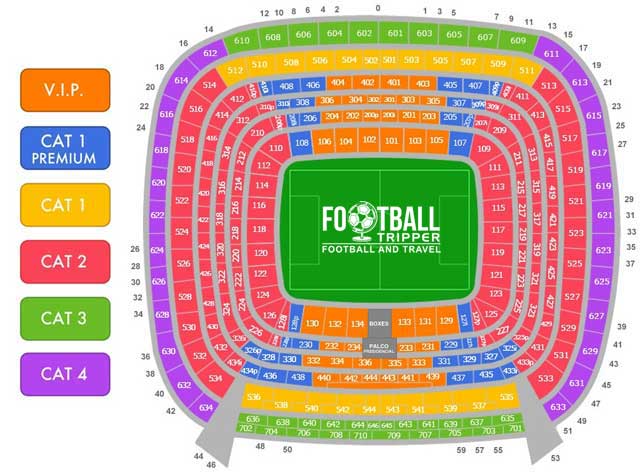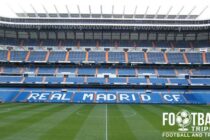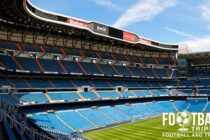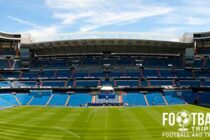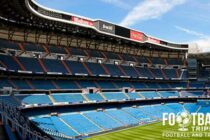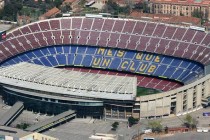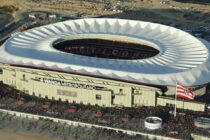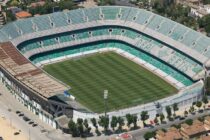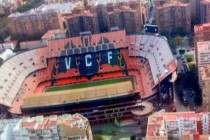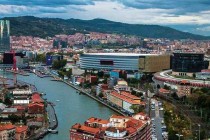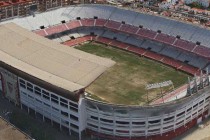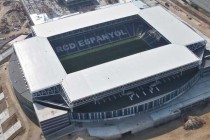Estadio Santiago Bernabéu is the legendary home stadium of mega-rich Real Madrid football club and one of the most prestigious stages in world football.
In 2013, the club announced plans to increase capacity to 90,000 although whether or not this will be cost effective remains to be seen.
Real Madrid Stadium Guide
Stadium Facts
| Overview | |
|---|---|
| Team: | Real Madrid |
| Opened: | 1947 |
| Capacity: | 81,044 |
| Address: | Av de Concha Espina, 1, Chamartín, Madrid, 28036 |
| Pitch Size: | 105m × 68m |
| Record Attendance: | 129,690 vs AC Milan (19th April 1956) |
| Stadium Owner: | Real Madrid F.C. |
| Operator: | Real Madrid F.C. |
| Wikipedia: | https://en.wikipedia.org/wiki/Santiago_Bernab%C3%A9u_Stadium |
| Stadium Names | |
| Names: | El Bernabéu, Estadio Santiago Bernabéu (Spanish), Santiago Bernabéu Stadium (English) |
| Former Names: | Estadio Real Madrid Club de Fútbol (1947–1955) |
| Construction Details | |
| Broke Ground: | October 1944 |
| Built: | 1944-1947 |
| Architect: | Manuel Muñoz Monasterio, Luis Alemany Soler, Antonio Lamela (Expansion) |
| Expanded: | 1953, 1992, 1994, 2011 |
| Renovated: | 1982, 2001, 2020–present |
Santiago Bernabéu History
The Bernabéu origins date back to 1924 when the Campo De O’Donnell was deemed too small for the club after the club quickly outgrew their new facilities.
With the city of Madrid beginning a love affair with football, the club’s then president Santiago Bernabéu decreed that Los Blancos required a stadium of at least 100,000 capacity, and promptly set about making his vision a reality.
Construction on the ambitious project commenced in 1945 and the first football match was officially held two years later on the 14th December 1947 where the club defeated the Portuguese champions OS Belenenses 3-1.
Initially christened Nuevo Estadio Chamartín, it was renamed eight years after opening to Estadio Santiago Bernabéu in 1955 to recognise the presidents extraordinary efforts.
Despite developing a reputation as one of the finest grounds in Europe, the current stadium was only capable of accommodating around 75,000 fans and thus by the presidents own high standards was currently a failure.
Initially consisting of stands which had two uncovered tiers, the first expansion occurred in 1954 bringing the capacity up to 125,000 which went above and beyond the esteemed president’s initial vision.
Throughout Bernabéu’s 35 year tenure at the club, Real Madrid forcefully became a European powerhouse and the stadium’s reputation as one of the greatest footballing venues in the world became cemented.
During the Euro 1964 Championships Madrid’s stadium hosted both the semi-final and final, and in 2010 Santiago Bernabéu hosted its fourth European Cup final between Inter Milan and Bayern Munich.
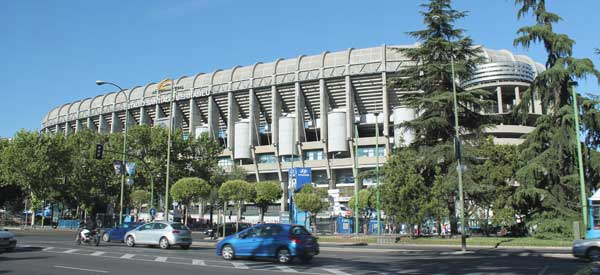
View of Santiago Bernabéu
Future Developments
As for the future of Santiago Bernabéu it appears that Los Merengues favour expansion of their stadium rather than relocation. Currently the second largest stadium in Spain behind Barcelona’s Camp Nou, you get the sense that the club won’t stop until they have a bigger and better stadium than their rivals.
Real Madrid Info
| Full Name: | Real Madrid Club de Fútbol |
|---|---|
| Rivals: | Barcelona (El Clásico), Atletico Madrid (El Derbi Madrileño), Athletic Bilbao (El Viejo Clásico), Bayern Munich, Juventus |
| Founded: | 1902 |
| Team Colours: | White |
| Nicknames: | Los Blancos (The Whites), Los Merengues (The Meringues), La Casa Blanca (The White House) |
| Training Ground: | Valdebebas |
| Former Stadiums: | Campo de O'Donnell (1912-1923), Campo de Ciudad Lineal (1923-1924), Estadio Chamartín (1924-1946), Estadio Alfredo Di Stéfano (2020-2021) |
| Famous Players: | Alfredo Di Stéfano, Ferenc Puskás, Iker Casillas, Sergio Ramos, Roberto Carlos, Luis Figo, Raul, David Beckham, Ronaldo (Brazilian), Gareth Bale, Cristiano Ronaldo, Karim Benzema |
| Famous Managers: | Miguel Muñoz, Vicente del Bosque, Carlo Ancelotti, José Mourinho, Zinedine Zidane |
| Team Goalscorer: | Cristiano Ronaldo (450) |
| Most Appearances: | Raúl (741) |
| Official Website: | https://www.realmadrid.com/en |
| Team Wikipedia: | https://en.wikipedia.org/wiki/Real_Madrid_CF |
Santiago Bernabéu Seating Plan
Stand Photos
Matchday Experience
Santiago Bernabéu Away Section
Away fans are usually confined to a small section of seating within the fourth tier of the north-east corner which is accessible via Tower (Torre) D.
Spanish Football doesn’t really have the same away fan culture as some other European countries so it’s not uncommon for the number of visiting supporters to be less than a few hundred. In September 2014 there were press reports that of the 350 tickets allocated to Atletico Madrid for the local derby only 30 had been purchased which is almost incomprehensible in the United Kingdom.
Thankfully the size of the away section is increased during Champions Leagues nights with Manchester United allocated a sizeable 3,800 tickets for their mouth-watering quarter-final clash in 2013. Tickets on this occasion cost £62.50 for the upper section and £70.50 for the lower.
Best Pubs near ground
As the Spanish Capital the large city centre is full of plenty places todrink, and it is almost impossible to go without seeing a bar within five minutes. The best news is that most them close at around 3.00 am which means you can decant to one of the lively Irish Bars and pick apart the match into the wee small hours.
If you’re a Madrid supporter or heading to the ground as a neutral there’s quite a few boozers located within the immediate environs of the Bernabeu, otherwise as an away fan you might want to frequent some of the sports bars in the city centre as per the map.
Food - Places to eat
As Estadio Santiago is situated Paseo de la Castellana which is a main road in the city, the surrounding area has a decent choice of eating and drinking options for before or after the match. The more residential looking parts have a strong selection of smaller coffee shops, independent eateries and bars, with inside the stadium there being numerous kiosks that sell typical fast football food.
A popular choice for tourists is the adjacent shopping centre which is named La Esquina del Bernabéu (again after the president) which has a food court and more food choices such as TGI Fridays and Tony Roma’s if you’re feeling unadventurous.
Real Madrid Club Shop

Real Madrid Club Shop
The main club shop located at the Bernabeu is over 1500 metres squared in size, and is one of the largest football shops in the world. Located at Entry point C, Gate 55 on Padre Damián it houses the greatest selection of Madrid merchandise Los Blancos fans can expect to find anywhere in the world.
Opening Times
- Monday to Saturday: 10.00 am to 9.00 pm
- Sundays: 11.00 am to 7.30 pm
Can you take a stadium Tour?
Madristas can now go behind the scenes at the Bernabéu by undertaking a fully-guided tour of the historic and iconic facilities. Costing just €19.00 for adults and €13.00 for children it really is a bargain and rightly so one of the most popular tourist attractions in the city.
Opening Times
- Non Matchdays: Monday to Saturday: 10.00 am – 7.00 pm, Sundays and public holidays: 10.30 am – 6.30 pm
- Matchdays: Tours available until 5 hours before the beginning of the game.
For more information you can email the club via [email protected] or phone them on +34 91 398 43 70
How to buy Real Madrid Tickets
Tickets for Real Madrid matches like other clubs in Spain can be purchased online, by phone +34 902 32 43 24 or at the taquillas (ticket windows) at the stadium itself.
With the large capacity, Real doesn’t often sell out their home matches meaning you can often pick up tickets a week before the match, although it depends on the opponents. Many fans have noted that you can even purchase tickets for matches via ServiCaixa cash points around the city which definitely sound like a convenient option for tourists.
Ticket prices vary greatly depending on who Real are playing but to give you an estimate of the range, the cheapest seat which would be in the upper-tier behind the goal will set you back around €28.00 with a prime seat more central along the main stands taking you up to €120.00.
How to get to Santiago Bernabéu
Where is Santiago Bernabéu?
Estadio Santiago Bernabéu is located towards the North of the city, with some fans giving an estimation of 4 km based on the located of Plaza de Cibeles which is regarded as an iconic part of Madrid.
Driving
Driving instructions are slightly redundant due to the popularity of satnavs, so all I can really give you is the address to type in:
- Av. Con-cha Espina 1, 28036, Madrid – España
Car Parks
Parking is available in small quantities around the stadium but on a first come first serve basis, get there early.
Train - Public Transport
The main train station is Madrid Atocha or Estación de Madrid Atocha which serves a number of commuter, intercity and regional trains throughout Spain, making a day trip to see Los Blancos entirely feasible if you’re on holiday elsewhere in the country.
Located 5.8 km from the stadium, the metro lines C-1, C-2, C-3, C-4, C-7 and C-10 will take you there in no more than 20 minutes.
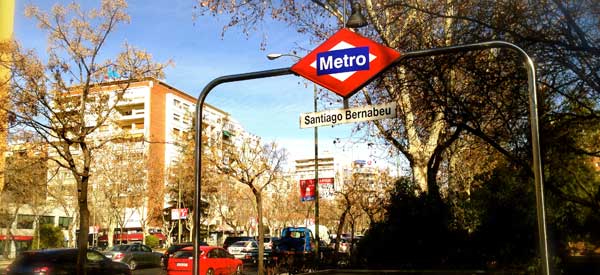
Public Transport of Santiago Bernabéu
Metro
You can get to the ground via metro line 10 which stops next to the stadium and departs from either Plaza de España or Tribunales. If you aren’t on the right line, don’t worry as you can easily transfer.
Airports and Flying
Madrid is served by Adolfo Suárez Madrid–Barajas Airport which is Europe’s 6th busiest airport and the country’s biggest, flying over 49 million passengers a year.
Located 12 km away from Santiago Bernabéu, the Madrid metro line connects the airport to Nuevos Ministerios station which is large metro station in the city. Failing this there is the EMT Bus service which also does the trick.
Hotels Near Santiago Bernabéu
The Estadio is generously supplied with nearby accommodation options such as AC Hotel Aitana, Holiday Inn and the Best Western although they convenient, they certainly aren’t the cheapest or best placed to visit the usual tourist sights of Madrid.
For this, you may wish to stay further South, closer to Plaza Mayor with hotels such as Hotel Europa, Hostal Persal and Hotel Cortezo being decent choices for those on a budget.
Frequently Asked Questions
Who plays at Santiago Bernabéu?
Spanish side Real Madrid play their home matches at Santiago Bernabéu.
What is the capacity of Santiago Bernabéu?
As of 2024 Santiago Bernabéu has an official seating capacity of 81,044 for Football matches.
When was Santiago Bernabéu opened?
Santiago Bernabéu officially opened in 1947 and is home to Real Madrid
What is the postcode for Santiago Bernabéu?
The postcode for Santiago Bernabéu is 28036.
Are there any Covid restrictions at the stadium?
Covid Restrictions may be in place when you visit Santiago Bernabéu in 2024. Please visit the official website of Real Madrid for full information on changes due to the Coronavirus.


